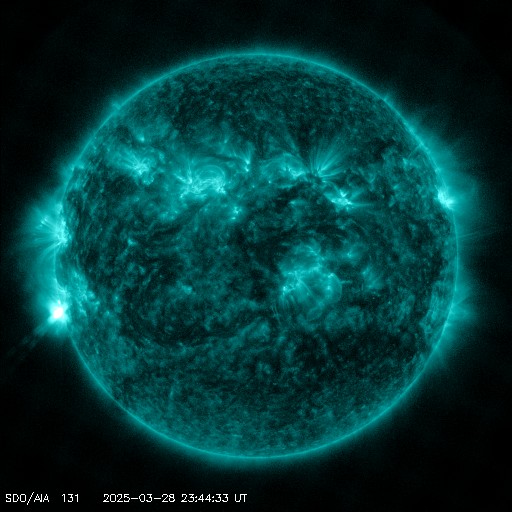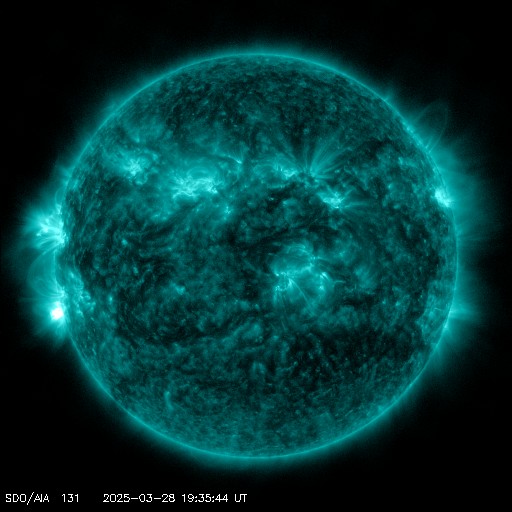Viewing archive of Sunday, 7 April 2002
Solar activity report
Any mentioned solar flare in this report has a scaling factor applied by the Space Weather Prediction Center (SWPC). Because of the SWPC scaling factor, solar flares are reported as 42% smaller than for the science quality data. The scaling factor has been removed from our archived solar flare data to reflect the true physical units.
Report of Solar-Geophysical Activity 2002 Apr 07 2200 UTCPrepared by the NOAA © SWPC and processed by SpaceWeatherLive.com
Joint USAF/NOAA Report of Solar and Geophysical Activity
SDF Number 097 Issued at 2200Z on 07 Apr 2002IA. Analysis of Solar Active Regions and Activity from 06-2100Z to 07-2100Z
Solar activity was at low levels. Region 9893 (N18E27)
produced most of today's activity as well as the largest flare of
the day, a C9/1f flare occurring at 07/0523 UTC. The growth of
several additional spots seen today in this region although areal
coverage went mostly unchanged from yesterday. A source region
beyond the east limb produced a Type II radio sweep at 07/0012 UTC
that had an estimated shock velocity of 586 km/s. LASCO
differencing imagery captured an east limb CME shortly after the
Type II was observed, although it is unlikely this event will be
geoeffective. New Regions 9900 (S29E07), 9901 (N20E37), and 9902
(N11E75) were numbered today.
IB. Solar Activity Forecast
Solar activity is expected to be
predominantly low to moderate, although Region 9893 and 9897
(S02W17) both possess the potential to produce an isolated major
flare.
IIA. Geophysical Activity Summary 06-2100Z to 07-2100Z
The geomagnetic field activity was at quiet to unsettled levels. The
greater than 2 MeV electron flux observed at geosynchronous orbit
continued a steady drop from moderately enhanced levels today.
IIB. Geophysical Activity Forecast
Geomagnetic field activity is
expected to be at quiet to unsettled levels with isolated active
periods possible on days one and two of the forecast period. Day
three should return to predominantly quiet conditions. The greater
than 2 Mev electron flux should be slightly enhanced through the
first day of the period.
III. Event Probabilities 08 Apr to 10 Apr
| Class M | 60% | 60% | 60% |
| Class X | 10% | 10% | 10% |
| Proton | 05% | 05% | 05% |
| PCAF | green | ||
IV. Penticton 10.7 cm Flux
Observed 07 Apr Predicted 08 Apr-10 Apr 200/190/185 90 Day Mean 07 Apr 201
V. Geomagnetic A Indices
Observed Afr/Ap 06 Apr 004/005 Estimated Afr/Ap 07 Apr 008/010 Predicted Afr/Ap 08 Apr-10 Apr 012/012-007/007-004/007
VI. Geomagnetic Activity Probabilities 08 Apr to 10 Apr
| A. Middle Latitudes | |||
|---|---|---|---|
| Active | 20% | 20% | 15% |
| Minor storm | 05% | 01% | 01% |
| Major-severe storm | 01% | 01% | 01% |
| B. High Latitudes | |||
|---|---|---|---|
| Active | 25% | 20% | 15% |
| Minor storm | 10% | 05% | 01% |
| Major-severe storm | 01% | 01% | 01% |
All times in UTC
Current data suggests there is a slight possibility for aurora to appear at the following high latitude regions in the near future
Norilsk, VorkutaLatest news
Latest forum messages
AR4046 127Incoming & Unnumbered Active Regions 1657Aurora photography hints for those of us with smartphones 49Large Coronal Hole 25 178LASCO Data Not Updating 5
More topicsSupport SpaceWeatherLive.com!
A lot of people come to SpaceWeatherLive to follow the Sun's activity or if there is aurora to be seen, but with more traffic comes higher server costs. Consider a donation if you enjoy SpaceWeatherLive so we can keep the website online!

Latest alerts
00:00 UTC - Solar flare
Moderate M1.79 flare
Friday, 28 March 2025
23:36 UTC - Radio Blackout
Minor R1 radio blackout in progress (≥M1 - current: M1.04)
21:24 UTC - Hemispheric Power Index
The OVATION model predicts the Hemispheric Power Index to reach 51GW at 21:59 UTC
19:45 UTC - Solar flare
Moderate M1.16 flare
19:27 UTC - Radio Blackout
Minor R1 radio blackout in progress (≥M1 - current: M1.1)
Space weather facts
| Last X-flare | 2025/03/28 | X1.1 |
| Last M-flare | 2025/03/28 | M1.7 |
| Last geomagnetic storm | 2025/03/27 | Kp5 (G1) |
| Spotless days | |
|---|---|
| Last spotless day | 2022/06/08 |
| Monthly mean Sunspot Number | |
|---|---|
| February 2025 | 154.6 +17.6 |
| March 2025 | 128.3 -26.4 |
| Last 30 days | 128.3 -23.7 |




